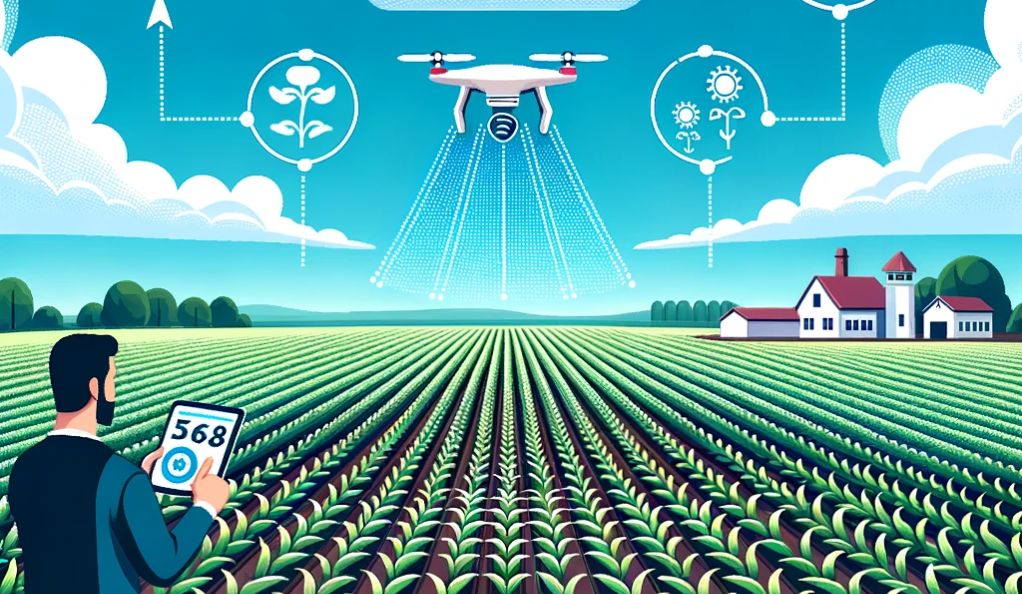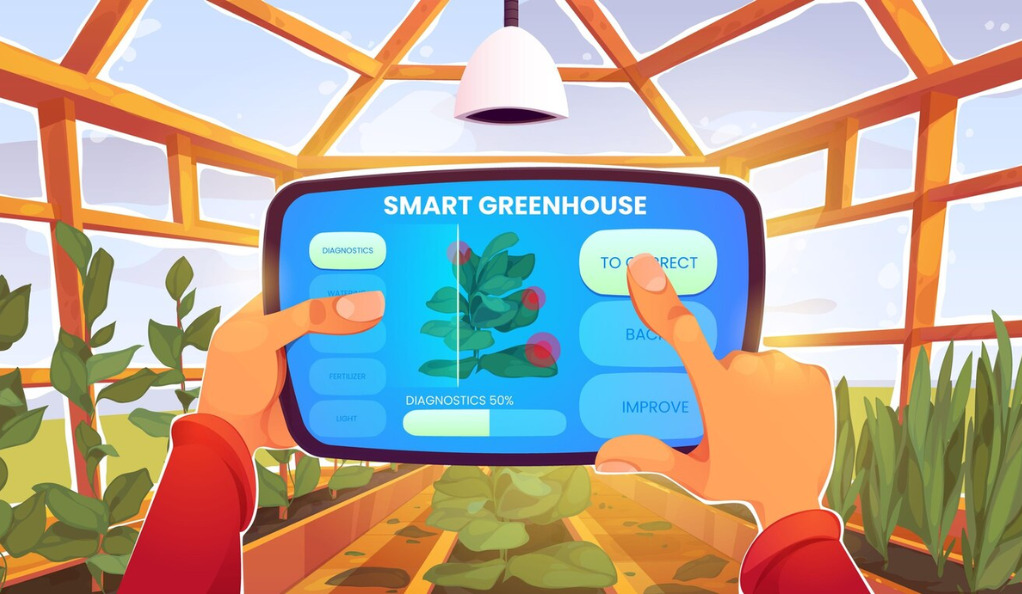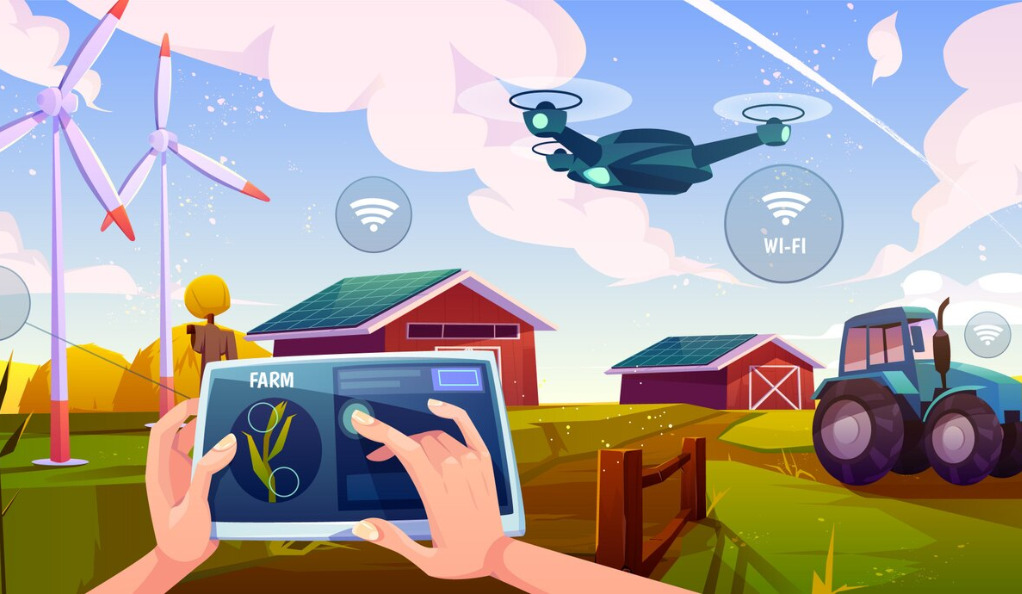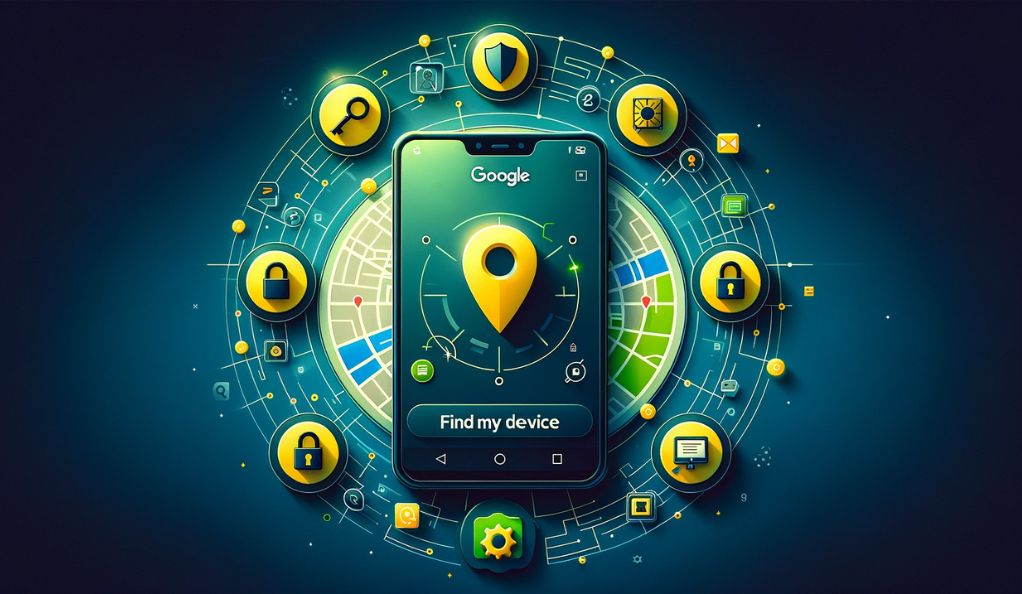The dawn of the 21st century brought with it a technological revolution that has permeated every sector, and agriculture is no exception. The integration of the Internet of Things (IoT) into farming practices is reshaping the agricultural landscape, ushering in an era of ‘Smart Farming’. But what exactly does this mean, and why is it pivotal for the future of agriculture?
What is IoT in Agriculture?
IoT, or the Internet of Things, refers to the network of physical devices embedded with sensors, software, and other technologies that allow them to connect and exchange data over the internet. In the context of agriculture, this means using these devices to collect, analyze, and utilize data in real-time to enhance farming operations.
From Traditional to Smart Farming
Traditionally, farming relied heavily on manual labor, intuition, and time-tested methods. While these practices have their merits, they often lack the precision and efficiency needed to meet the growing global food demand. Enter Smart Farming – a system where IoT devices monitor and analyze various farm parameters like soil moisture, weather conditions, crop health, and more. This data-driven approach allows farmers to make informed decisions, optimize resources, and increase crop yields.
| Traditional Farming | Smart Farming |
|---|---|
| Relies on manual observation | Uses sensors and devices for real-time monitoring |
| Decisions based on intuition and experience | Data-driven decision-making |
| Resource-intensive | Optimized resource usage |
| Reactive approach to problems | Proactive and predictive solutions |
The Potential of IoT in Agriculture
The potential benefits of integrating IoT into agriculture are vast. For instance, smart irrigation systems can detect soil moisture levels and provide water only when necessary, reducing water wastage. Drones equipped with cameras can monitor large swathes of land, identifying potential pest infestations or diseases before they spread. Automated tractors can till, sow, and harvest with pinpoint accuracy, reducing labor costs and increasing efficiency.
In essence, the fusion of IoT with agriculture is not just a trend; it’s a necessity. As the global population continues to rise, and the demand for food increases, leveraging technology to secure the future of farming becomes imperative. The journey from sowing seeds based on age-old wisdom to harnessing the power of interconnected devices represents not just evolution but a revolution – one that promises a sustainable, efficient, and prosperous future for agriculture.
Historical Context of IoT
To truly appreciate the transformative power of IoT in agriculture, it’s essential to understand its origins and evolution. The concept of interconnected devices isn’t as modern as one might think; it has roots that trace back decades.
The Birth of the “Internet of Things”
The term “Internet of Things” was coined in 1999 by Kevin Ashton, a British technology pioneer. While working at the Massachusetts Institute of Technology (MIT), Ashton envisioned a world where “things”, not just computers, could be connected to the internet, sharing and receiving data. This idea was revolutionary, suggesting a future where everyday objects could communicate without human intervention.
Early Forays into IoT
One of the first instances of a connected device was a Coke vending machine at Carnegie Mellon University in 1982. This machine was rigged to report its inventory and whether the drinks were cold, allowing students to check its status without physically being there. While this might seem rudimentary now, it was a glimpse into the potential of connected devices.
In the early 2000s, companies began to see the commercial potential of IoT. LG Electronics introduced a refrigerator that could be connected to the internet, tracking the food items inside it. Although it didn’t gain widespread popularity due to its high cost, it set the stage for the smart appliances we see today.
IoT’s Expansion Beyond Consumer Electronics
While the consumer market was quick to adopt IoT, with smartwatches and home management products becoming commonplace, its application in industries like agriculture took a bit longer. However, once the potential benefits became clear – from increased efficiency to reduced costs – the agricultural sector began its journey towards digitization.
IoT and Agriculture: A Match Made in Tech Heaven
The marriage of IoT and agriculture was driven by necessity. With the global population booming and arable land decreasing, there was a pressing need to make farming more efficient. IoT provided the tools to do just that. Sensors could monitor soil health, drones could survey vast areas quickly, and data analytics could provide insights into optimizing crop yields.
The transition wasn’t without its challenges. There were concerns about data security, the cost of implementing these technologies, and a lack of understanding about their potential benefits. However, as success stories began to emerge, the agricultural community started to embrace IoT wholeheartedly.
IoT Technologies in Agriculture

The integration of IoT in agriculture has paved the way for a myriad of technologies that are revolutionizing farming practices. These technologies, while diverse in their applications, share a common goal: to make farming more efficient, sustainable, and profitable.
Sensors: The Eyes and Ears of Smart Farming
At the heart of IoT in agriculture are sensors. These tiny devices, when strategically placed across a farm, can monitor a variety of parameters. From soil moisture and temperature to ambient light and humidity, sensors provide real-time data that can be crucial for decision-making.
For instance, soil sensors can detect when the ground becomes too dry, triggering an automated irrigation system to water the crops. Similarly, sensors can monitor the health of crops, detecting signs of disease or pest infestation early on, allowing farmers to take preventive measures.
Automated Irrigation: Watering with Precision
Water is a precious resource, and its efficient use is paramount in agriculture. Automated irrigation systems, powered by IoT, ensure that crops receive the exact amount of water they need. By analyzing data from soil moisture sensors, these systems can determine when and how much to water, reducing wastage and ensuring optimal crop growth.
Drones: A Bird’s-Eye View of the Farm
Drones, or Unmanned Aerial Vehicles (UAVs), have found a significant place in modern agriculture. Equipped with cameras and sensors, drones can quickly survey large areas of land, providing high-resolution images that can be analyzed for various purposes. Whether it’s assessing crop health, monitoring the growth of plants, or mapping out areas for planting, drones offer a perspective that was previously hard to achieve.
Machine Learning and Data Analytics: Turning Data into Insights
The data collected by IoT devices is vast. However, raw data in itself isn’t very useful. This is where machine learning and data analytics come into play. By analyzing this data, farmers can gain insights into their farming practices, understanding what works and what doesn’t. Over time, machine learning algorithms can predict outcomes based on historical data, allowing farmers to make informed decisions about planting, harvesting, and more.
Connectivity: The Backbone of IoT in Agriculture
For all these technologies to work seamlessly, a robust connectivity framework is essential. Whether it’s the communication between sensors and a central system or the transmission of data from drones to a cloud server, reliable internet connectivity ensures that data flows smoothly and decisions are made in real-time.
Robotics in Agriculture
The rise of robotics in the agricultural sector represents a significant leap towards automating many of the labor-intensive tasks that farmers face daily. These machines, often referred to as ‘Agribots’, are designed to operate with precision, efficiency, and consistency, making them invaluable assets on the modern farm.
Agribots: The Future of Farming
Agribots are specialized robots designed for agricultural tasks. Their rise can be attributed to several factors:
- Labor Shortages: Many agricultural regions face labor shortages, especially during peak seasons. Robots can fill this gap, working around the clock without fatigue.
- Precision and Consistency: Robots can perform tasks with a level of precision that’s hard for humans to match. Whether it’s planting seeds at exact depths or picking ripe fruits without causing damage, agribots ensure consistency in every action.
- Cost Efficiency: While the initial investment in robotics can be high, over time, they can lead to significant savings in labor costs and increased productivity.
Types of Agricultural Robots and Their Applications
- Weeding Robots: These robots use advanced image processing to differentiate between crops and weeds. Once identified, they can either physically remove the weeds or apply targeted herbicides, ensuring that crops remain unaffected. This not only reduces the amount of herbicide used but also ensures that crops aren’t competing with weeds for nutrients.
- Machine Navigation: Modern tractors and other heavy farm machinery can be equipped with autonomous navigation systems. Using GPS and onboard sensors, these machines can plow, sow, and harvest fields with minimal human intervention. They can also adjust their operations in real-time based on terrain and other factors.
- Harvesting Robotics: Picking fruits and vegetables is a delicate process that requires care to ensure the produce isn’t damaged. Harvesting robots use a combination of cameras and tactile sensors to pick and sort produce. They can be especially useful for high-value crops like grapes, strawberries, and tomatoes.
- Material Handling: These robots can perform tasks like packaging, palletizing, and transporting goods within the farm. They ensure that post-harvest processes are efficient and reduce the chances of produce getting damaged.
Challenges and the Road Ahead
While the potential of robotics in agriculture is immense, there are challenges to overcome. The initial cost of investment, the need for skilled personnel to operate and maintain these robots, and concerns about job displacements are some of the issues facing the widespread adoption of agribots.
Drones: The Eyes in the Sky

Drones, once primarily associated with military operations or recreational photography, have found a transformative role in modern agriculture. These flying marvels have become indispensable tools, offering farmers a bird’s-eye view of their fields and providing insights that were once difficult or time-consuming to obtain.
Why Drones Matter in Agriculture
The vastness of agricultural lands means that monitoring every nook and corner manually can be a daunting task. Drones simplify this by covering large areas in a short time, capturing detailed images that can be analyzed for various agricultural needs.
Types of Drones and Their Specific Uses in Agriculture
- Fixed-Wing Drones: Resembling a traditional airplane in design, these drones can cover vast distances and are ideal for surveying large farms. They provide a broad overview, helping farmers get a general sense of their land’s condition.
- Multi-Rotor Drones: More common and resembling the typical consumer drones, these are perfect for more detailed, localized observations. They can hover in a single spot, making them ideal for close-up inspections of crops, irrigation systems, or infrastructure.
- Hybrid Drones: Combining features from both fixed-wing and multi-rotor drones, these offer both range and detailed inspection capabilities.
Applications of Drones in Agriculture
- Crop Monitoring: Drones can quickly identify areas affected by pests, diseases, or insufficient hydration. Early detection means timely intervention, saving crops that might otherwise be lost.
- Soil Analysis: Before planting, drones equipped with special sensors can create detailed maps for soil analysis. This helps in planning seed planting patterns, optimizing irrigation, and more.
- Irrigation Monitoring: Drones can identify areas where irrigation systems might be malfunctioning or where water is pooling, ensuring that crops receive consistent and adequate water.
- Livestock Monitoring: For those with vast ranches, drones can monitor the well-being of livestock, track their movements, and even detect if any animals have strayed from the herd.
- Growth Monitoring: By regularly surveying crops, drones can provide data on their growth. This data can be used to predict yields and determine the best harvest times.
The Future of Drones in Agriculture
As drone technology continues to advance, their applications in agriculture will expand. We can expect drones equipped with AI capabilities that can not only detect problems but also offer solutions. For instance, drones might soon be able to identify a pest infestation and then deploy beneficial insects to combat it.
Moreover, the integration of drones with other IoT devices on the farm will lead to even more synchronized and efficient farming practices. Imagine a drone detecting dry soil and then communicating with an automated irrigation system to water that specific area.
Remote Sensing: The Silent Watchers
In the vast expanse of agricultural fields, there’s a need for constant vigilance. Remote sensing technologies have emerged as the silent guardians of these lands, providing farmers with invaluable data without the need for physical presence. This technology, which involves observing and measuring objects from a distance, typically using satellites or aircraft, has become a cornerstone of modern agriculture.
The Power of Remote Sensing in Agriculture
Remote sensing allows for the collection of data on a scale and precision that would be impossible with manual methods. By capturing images across various wavelengths, from visible light to infrared and beyond, it provides a multi-faceted view of agricultural lands.
Applications in Agriculture
- Crop Health Monitoring: Using specific wavelengths, remote sensing can detect the health of crops. Healthy plants reflect light differently than stressed or diseased plants. By analyzing these reflections, farmers can pinpoint areas that need attention.
- Soil Quality Assessment: Before planting, understanding the soil’s composition and quality is crucial. Remote sensing can provide detailed maps showing soil moisture levels, organic content, and even salinity.
- Weather Impact Analysis: After extreme weather events, such as storms or droughts, remote sensing can assess the damage, helping farmers strategize their recovery efforts.
- Yield Prediction: By monitoring crop growth and health throughout the season, remote sensing can help predict harvest yields, aiding farmers in market planning.
- Water Resource Management: Water is a precious commodity in agriculture. Remote sensing can monitor water bodies, track usage, and even predict future availability based on various factors.
Integration with IoT
While remote sensing provides a wealth of data, its true potential is unlocked when integrated with other IoT devices on the farm. For instance, data about soil dryness can trigger automated irrigation systems. Information about pest infestations can activate drone surveys for a closer look or even alert robotic systems to address the issue.
Computer Imaging: A New Perspective
In the digital age, the power of visual data cannot be understated. Computer imaging, which involves capturing and processing visual information using computers, has opened up new horizons in agriculture. By transforming the way we see and analyze our farms, this technology offers insights that are both profound and actionable.
The Magic of Computer Imaging in Agriculture

At its core, computer imaging is about extracting meaningful information from visual data. In agriculture, this means analyzing images of crops, soil, and even livestock to derive insights that can guide farming practices.
Applications in Agriculture
- Crop Quality Control: One of the primary uses of computer imaging is in assessing the quality of crops. High-resolution images can be analyzed to detect imperfections, diseases, or signs of pest damage. This ensures that only the best produce reaches the market.
- Irrigation Monitoring: Computer imaging can detect variations in crop color, indicating areas of insufficient hydration. By pinpointing these areas, farmers can adjust their irrigation systems to ensure even water distribution.
- Growth Pattern Analysis: By regularly capturing images of crops and analyzing them, farmers can monitor growth patterns. This can help in predicting harvest times and yields.
- Livestock Health Monitoring: In livestock farming, computer imaging can be used to monitor the health and well-being of animals. Any changes in posture, movement, or physical appearance can be indicators of health issues.
- Land Topography and Mapping: Before planting, understanding the lay of the land is crucial. Computer imaging can create detailed topographical maps, helping farmers plan their planting and irrigation strategies.
Integration with Other Technologies
Computer imaging doesn’t operate in isolation. When combined with other technologies like AI and machine learning, its capabilities are amplified. For instance, AI algorithms can automatically detect signs of diseases in crops, alerting farmers in real-time. Similarly, when integrated with drones, vast areas can be imaged and analyzed quickly.
Challenges and Concerns
While the integration of IoT and advanced technologies into agriculture heralds a new era of efficiency and productivity, it’s not without its challenges. As with any significant shift, there are concerns and obstacles that need addressing to ensure that the transition to smart farming is smooth and beneficial for all stakeholders.
Data Security and Privacy
One of the primary concerns with the widespread adoption of IoT in agriculture is data security. Farms generate vast amounts of data daily, from soil conditions to crop health. Ensuring that this data remains secure from cyber-attacks is paramount. There’s also the issue of data ownership and privacy. Farmers need to be confident that their data won’t be misused or sold without their consent.
Infrastructure and Connectivity
For IoT to function seamlessly, a robust infrastructure is essential. Many rural areas, where a significant portion of farming occurs, still lack reliable internet connectivity. Without this, the real-time data transfer and analysis that IoT promises become challenging.
High Initial Costs
The adoption of advanced technologies often comes with a hefty price tag. For many small-scale farmers, the initial investment required for IoT devices, drones, or robotics can be prohibitive. Finding ways to make these technologies more accessible is crucial for their widespread adoption.
Skill Gap and Training
Introducing new technologies means that farmers and agricultural workers need to acquire new skills. There’s a significant skill gap that needs bridging. Training programs and workshops are essential to ensure that the agricultural workforce can effectively use and benefit from these advancements.
Environmental Concerns
While technologies like IoT aim to make farming more sustainable, there are environmental concerns to consider. For instance, the production and disposal of electronic devices can have environmental implications. It’s essential to ensure that the push for technological advancement doesn’t come at the cost of the environment.
Societal Implications
The move towards automation and smart farming can lead to job displacements. While new roles will emerge, there’s a need to ensure that the transition doesn’t leave behind those who have been part of traditional farming practices for generations.
Conclusion
The challenges, while significant, are not insurmountable. With collaborative efforts from tech developers, policymakers, and the farming community, solutions can be found. It’s essential to approach the future with a balanced perspective, embracing the benefits of technology while addressing its challenges head-on.
The future of farming is undoubtedly exciting. As we navigate this new landscape, the goal remains the same: to ensure that agriculture remains sustainable, productive, and beneficial for everyone involved. The journey might be fraught with challenges, but with collaboration and innovation, a brighter future for agriculture is within reach.








